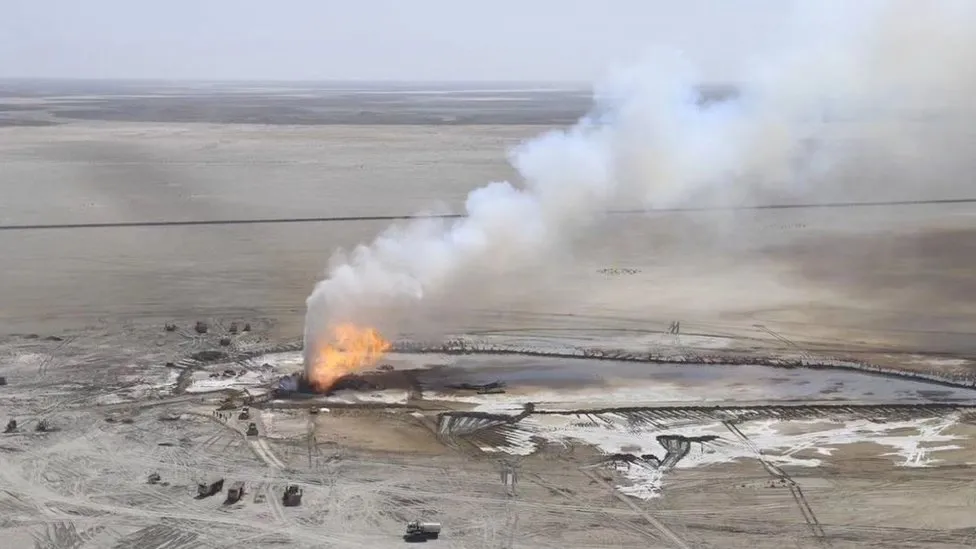
Table of Contents
A remote well in Kazakhstan experienced one of the worst methane leaks ever detected last year, according to new analysis provided with BBC Verify.
A blowout caused a fire that burned for more than six months, releasing an estimated 127,000 tons of gas into the atmosphere.
The greenhouse gas methane is far more powerful than carbon dioxide.
The well’s owner, Buzachi Neft, disputes that a “substantial amount” of methane was released.
The environmental effect of such a leak is equivalent to driving more than 717,000 gasoline-powered cars for a year, according to the US Environmental Protection Agency’s Greenhouse Gas Equivalency Calculator.
“The magnitude and the duration of the leak is frankly unusual,” said Manfredi Caltagirone, chairman of the UN’s International Methane Emissions Observatory. “It’s really large.”
On June 9, 2023, a blowout at an exploratory well in the Mangistau region of southwest Kazakhstan was recorded. This marked the beginning of the leak, and the fire continued unabated until the end of the year.
It wasn’t until December 25, 2023, that it was under control. The BBC was informed by local authorities that cement work is currently being done to seal the well.
It wasn’t until December 25, 2023, that it was under control. The BBC was informed by local authorities that cement work is currently being done to seal the well.
Methane, which is visible to the human eye, makes up the majority of natural gas.
However, certain satellites are able to trace the distinct fingerprint that is left behind when sunlight enters a methane cloud.
First to look into this specific methane leak was the French geoanalytics company Kayrros. The Netherlands Institute for Space Research and Valencia Polytechnic University in Spain have now validated their study.
Scientists examined the satellite data and discovered that, on 115 different occasions between June and December, large amounts of methane were evident.
Tthey estimated that 127,000 tons of methane had leaked from this particular well based on those results.
Given this, it might rank as the second-worst recorded man-made methane leak ever.
One person who assisted in confirming the leak is Luis Guanter of the Polytechnic University of Valencia, who believes that “only the Nord Stream sabotage may have led to a stronger leak.”
Up to 230,000 tons of methane were released into the atmosphere in September 2022 when underwater explosions destroyed the Nord Stream 1 and 2 pipelines, which carried Russian gas to Germany.
The International Energy Agency estimates that methane is roughly 30% to blame for the increase in global temperatures that has occurred since the Industrial Revolution.
Although environmental variables like cloud cover might impact satellite measurements, scientists are “completely sure” that large amounts of methane escaped from this particular source.
The Mangistau region’s Department of Ecology verified in a statement that, on ten different times between June 9 and September 21, the amount of methane in the air surpassed permissible levels.
It further stated that methane levels in the air were 50 times greater than permitted in the hours that followed the initial blowout.
However, the well’s Kazakhstani owner, Buzachi Neft, disputes claims that a significant amount of methane was released.
The company claims that the amount of gas in its well was “negligible” and that any methane that may have leaked would have burned as it emerged from the borehole.
It adds that it thinks the big white plumes that were seen from orbit were caused only by water vapor leaking into the atmosphere.
The business claims that it implies scientists failed to account for methane that was already present in the atmosphere prior to the blowout and that satellites may have confused other gases in the atmosphere, such as water vapor, for methane.
However, this is refuted by the teams that verified Kayrros’ first investigation into the breach.
According to Mr. Guanter of the Polytechnic University of Valencia, “we tested the potential effect of water vapour or smoke and we did not find any signal of those interacting with our measurements.”
Additionally, he stated that scientists only searched for “single methane plumes” and that the presence of methane in the atmosphere prior to the disaster would not have altered their methodology.
Kazakhstan pledges to reduce emissions of methane
Buzachi Neft was judged to have neglected to provide adequate supervision for the well digging, according to an official investigation into the accident’s causes conducted by the Industrial Safety Committee of Atyrau.
Additionally, it held subcontractor Zaman Energo accountable for multiple drilling process mishaps. Regarding this story, Zaman Energo declined to comment.
Kazakhstan’s Ministry of Energy said in a statement to the BBC that “there is no universal solution to eliminate similar accidents” and that dealing with the leak was a “complex technical operation.”
However, significant methane leaks have previously been found in Central Asia.
Similar to its neighbour, Turkmenistan, Kazakhstan has also recorded numerous “super-emitter” events; scientists refer to these as instances in which significant amounts of methane are released into the atmosphere.
However, Mr. Guanter claims that the occurrence seen in the Mangistau area is unique. “We have never observed a larger methane leak from ‘regular’ human activity,” he said.
According to climate specialists at Climate Action Tracker, Kazakhstan is at risk of more methane leaks from gas pipes due to an anticipated rise in natural gas production.
Kazakhstan became a member of the Global Methane Pledge, a voluntary commitment made by over 150 nations to reduce their methane emissions by 30% by 2030, during the COP28 climate meeting last year.